When you first stand at Sunset Crater, the black cinder fields look like a frozen wave—an eruption paused in time—and you’ll feel how recent geologic history can reshape a landscape overnight. You’ll learn the cone formed in 1085 CE and why its soils support unique plant life, and you’ll get practical routes, safety tips, and nearby stops to plan your visit — but there’s one access detail many visitors overlook that can change your whole day.
About the Monument and Its Geologic History
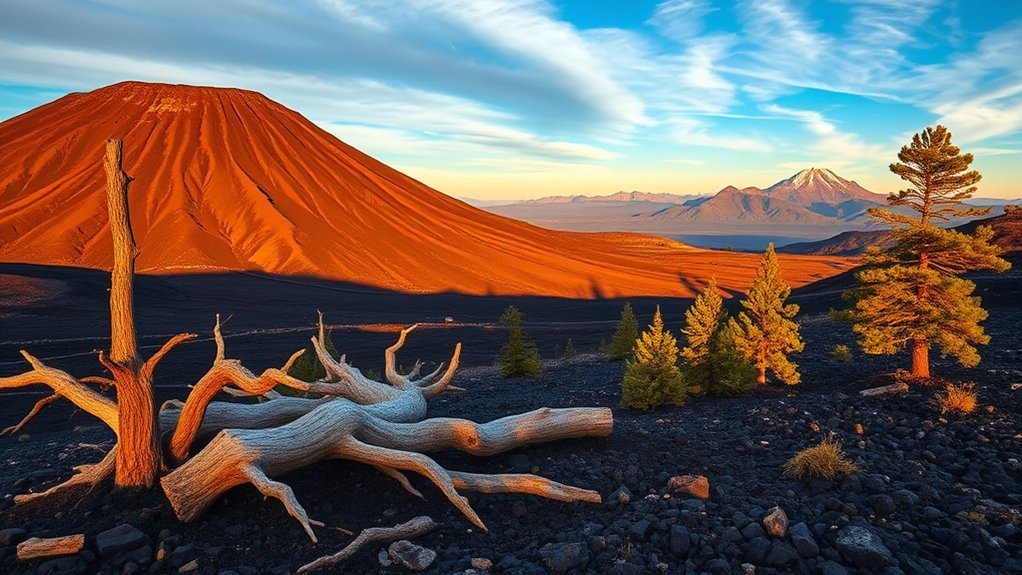
When you stand on the rim of Sunset Crater Volcano National Monument, you’re looking at Arizona’s most recent volcanic event — an eruption about 1085 CE that reshaped roughly 270 square miles of landscape. You’ll see a 1,120-foot cinder cone formed by explosive volcanic activity and an eruption column that lofted volcanic ash high into the atmosphere. The Bonito Lava Flow stretches 2.5 miles, preserving lava, ash, and multiple cinder cones that record this geological transformation. The monument sits within the San Francisco Volcanic Field, whose six-million-year geologic history includes diverse vents and flows. Volcanism forced nearby Ancestral Puebloan communities to relocate, altering human patterns as well as terrain. The site offers clear evidence of recent, consequential volcanic processes.
Planning Your Visit: Hours, Fees, and Directions
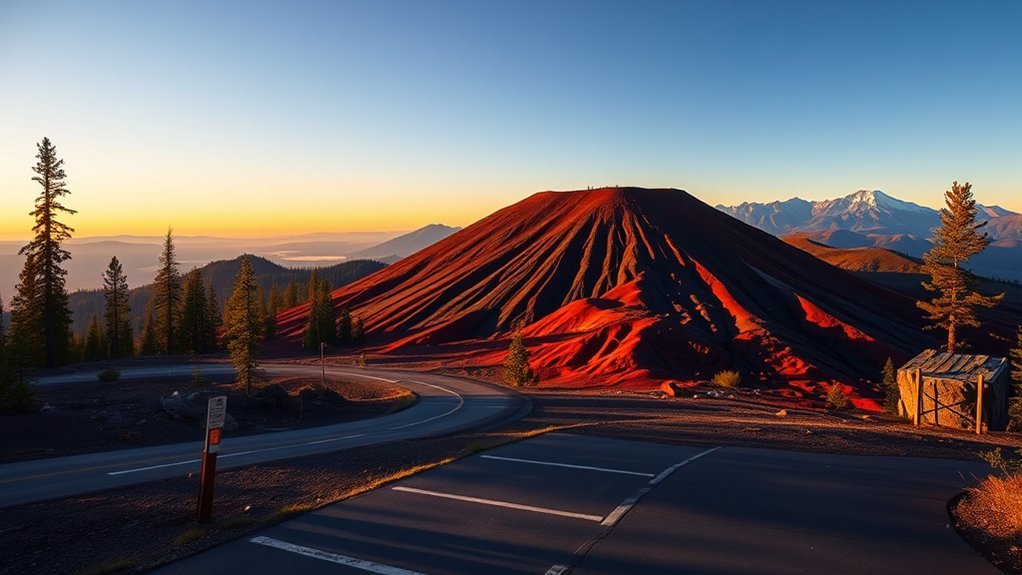
Plan your trip around seasonal hours: the monument’s visitor center is open 9 AM–5 PM from November to May and 8 AM–5 PM from May to October, and it’s closed on December 25. Expect a $20 vehicle entrance fee (or $15 for motorcycles, $10 for walkers/cyclists) with a $40 annual pass available, and remember one fee covers both Sunset Crater and Wupatki for seven days. From Flagstaff, drive U.S. 89 north 12 miles, turn right onto Sunset Crater–Wupatki Loop Road, and go 2 miles to the visitor center where parking is available but overnight parking isn’t permitted.
Hours and Seasonal Changes
Although the monument is open year‑round, the visitor center’s hours and seasonal conditions will shape how you plan your trip: the center generally runs 9:00 AM–4:30 PM (with extended seasonal hours of 9 AM–5 PM from November–May and 8 AM–5 PM from May–October) and is closed on Thanksgiving, Christmas, and New Year’s Day. When the Sunset Crater Volcano Visitor Center is open, staff can confirm current trail conditions, accessibility features, and any changes to the scenic loop. You’ll find hiking trails available in all seasons, but late spring offers vibrant wildflower blooms and milder temperatures. Check for seasonal activities such as guided walks and summer night sky programs. Note posted hours before arrival, and plan around reduced services on holidays.
Fees and Passes
Because access and parking rules affect how long you’ll explore the area, it’s helpful to know the monument’s fee structure and pass options before you arrive. The entrance fee is $20 per passenger vehicle, $15 per motorcycle, and $10 per cyclist or pedestrian; each ticket is valid for seven days and includes access to Wupatki National Monument. If you’ll return, an annual pass costs $40 and gives unlimited access to both parks for one year. The visitor center is open year‑round (9 AM–5 PM Nov–May; 8 AM–5 PM May–Oct) and closed on December 25. No public transportation serves Sunset Crater; you’ll drive about 30 minutes from Flagstaff via U.S. 89 and Sunset Crater–Wupatki Loop. Parking is available near the center and crater; overnight parking isn’t permitted.
Trails and Outdoor Activities
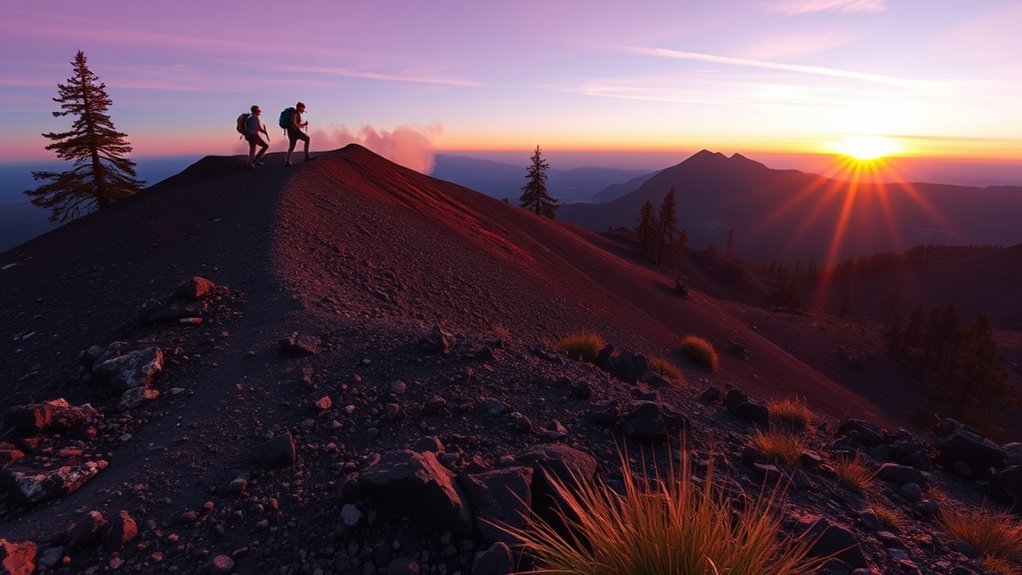
Sunset Crater offers five designated trails that let you safely explore its dramatic volcanic terrain, from an easy, pet-friendly paved section on the one-mile Lava Flow Trail to the fully accessible, one-third-mile Bonito Vista Trail with sweeping views of the Bonito Lava Flow. You can choose hikes that match your fitness and interests: the Lava Flow Trail and Bonito Vista Trail deliver scenic, family-friendly access, while the 1.6-mile Lenox Crater Trail is moderately strenuous and rewards you with panoramic views of surrounding volcanic peaks and landscape. As a visitor, plan time for short hikes and the roughly 35–38 mile loop drive to see diverse geological features without overexerting. Bring water, sturdy shoes, and respect trail rules for safety.
Flora, Fauna, and Cultural Significance
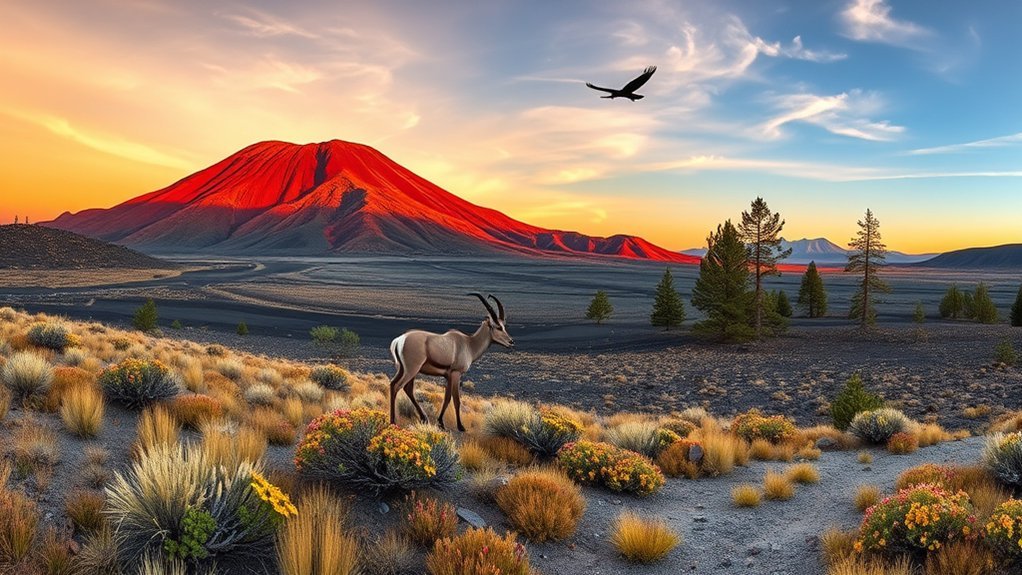
You’ll find unique plant species here, from ponderosa and pinyon pines to spring wildflowers like the rare Sunset Crater Beardtongue that colonize the volcanic soils. You’ll also observe wildlife adapted to the lava flows and learn how the 1085 eruption and its aftermath shaped Indigenous lifeways and settlements at nearby Wupatki. Pay attention to the landscape and night sky—both are integral to local cultural traditions and interpretation.
Unique Plant Species
One rare plant, the Sunset Crater beardtongue (Penstemon clutei), tells the story of life reclaiming volcanic rock: it’s endemic to these lava fields and thrives in the thin, nutrient-poor soils left by past eruptions. You’ll notice how unique flora punctuates the stark volcanic landscape, where black lava flows contrast with pockets of green. This resilient plant community — part of the broader flora and fauna mosaic — includes ponderosa pines and seasonal wildflowers that colonize sheltered soils. You can expect:
- Sunset Crater Beardtongue flourishing in crevices and gravel
- Ponderosa pines stabilizing soils near lava margins
- Spring wildflowers offering brief but brilliant displays
- Adapted shrubs and grasses defining recovery zones
These species underscore the site’s ecological and cultural significance.
Indigenous Cultural Ties
Because the land and its living things have long been woven into Indigenous lifeways, the plants, animals, and volcanic soils around Sunset Crater Volcano National Monument carry deep cultural meaning—used in ceremonies, medicine, food procurement, and place-based stories that guide stewardship. You’ll learn that the 1085 eruption reshaped settlement patterns, forcing Ancestral Puebloans into areas like Walnut Canyon and altering traditional practices. The rare Sunset Crater Beardtongue and other flora feature in ecological knowledge and help sustain biodiversity. Local wildlife, from elk to bobcats, figures in hunting strategies and spiritual beliefs. The volcanic landscape’s soils informed agricultural practices adapted to lava fields. Oral histories preserve guidance on resource use, underscoring cultural significance and ongoing Indigenous stewardship you should respect and support.
Nearby Attractions and Scenic Drives
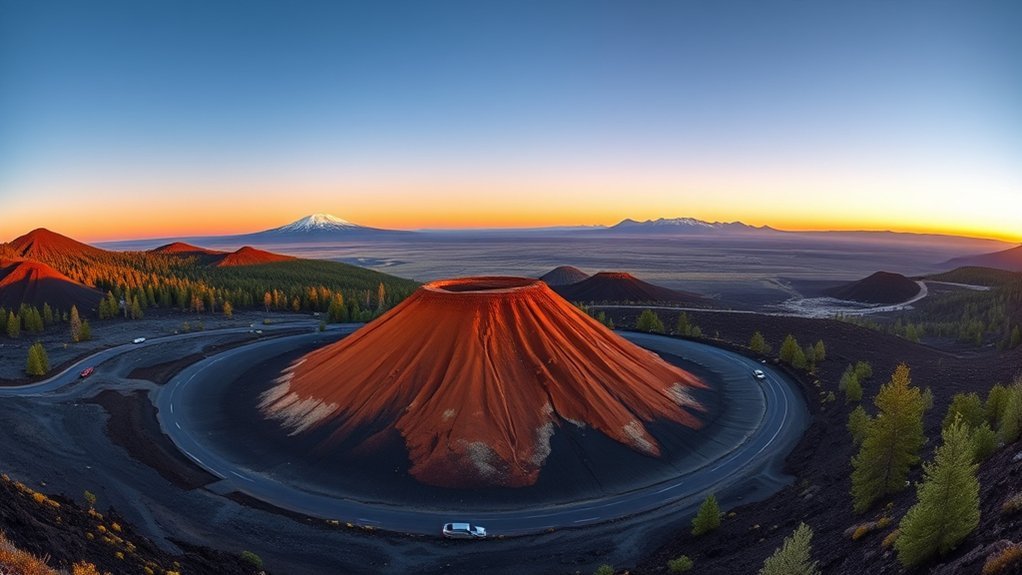
While exploring the 35–38 mile scenic loop around Sunset Crater Volcano National Monument, plan time to visit nearby highlights like Wupatki National Monument—accessible with the same entrance fee—so you can see Ancestral Puebloan ruins without backtracking. You’ll find a compact cluster of nearby attractions and scenic drives that complement volcanic landscapes, cultural sites, and forested recreation. Expect Painted Desert overlook vistas, deer and other wildlife along the route, and links to Flagstaff Area National Monuments.
- Wupatki National Monument: ancient Ancestral Puebloan ruins and visitor facilities.
- Painted Desert overlook: panoramic colors and photo opportunities.
- Walnut Canyon National Monument: cliff dwellings and short hikes.
- Coconino National Forest: expanded recreational opportunities, trails, and varied ecosystems.
Plan stops strategically to maximize time and context.
Visitor Tips: Accessibility, Safety, and What to Bring
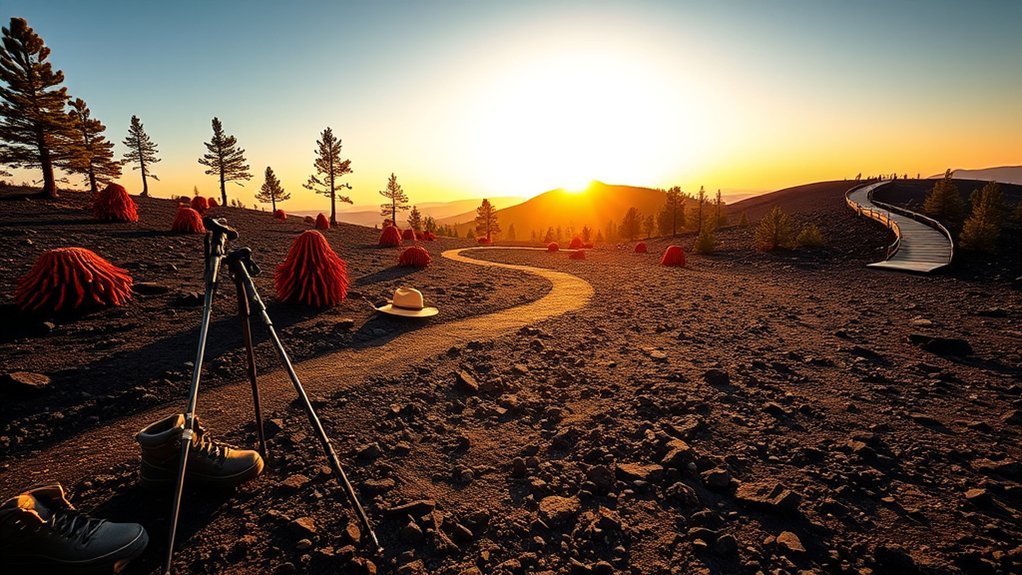
If you’re preparing for a visit, prioritize accessibility and safety by packing water, layers, and any mobility aids you need—wheelchairs aren’t available to rent at the monument. The visitor center is fully accessible, offers accessible parking and restrooms, and provides Braille brochures for guests with visual impairments. Two designated routes—the Bonito Vista Trail and the upper Lava Flow Trail—are designed for visitors with mobility challenges and give scenic, easy-to-navigate access. Always stay on marked trails to protect fragile geology and for your safety. Bring ample water and snacks, and pack layers to manage temperature changes caused by elevation. Check with staff at the visitor center for current conditions, accessibility details, and any additional safety advisories before heading out.
Frequently Asked Questions
How Long to Spend at Sunset Crater Volcano National Monument?
Plan 2–3 hours for a typical visitor experience; spend extra time if you want easier trail difficulty, scenic viewpoints, family activities, wildlife spotting, local geology, historical significance, photography tips, best seasons, and nearby attractions. You’ll enjoy it.
Is the Sunset Crater Volcano Worth Visiting?
You bet — it’s a must-see, and you’ll get volcano history, scenic views, hiking trails, wildlife sightings, visitor center info, geological features, photography spots, stargazing opportunities, cultural significance, and family activities all in one visit.
How Much Does It Cost to Go to the Sunset Crater?
It costs $20 per private vehicle (7 days), $15 motorcycle, $10 per person biking/walking; annual passes are $40. Entrance fees vary—check Visitor Center for Parking options, Guided tours, Discounted rates, Accessibility features, family activities, nearby attractions, camping.
How Long Is the Hike to Sunset Crater?
The main hikes range from about 0.3 to 1.6 miles; you’ll finish most trails in roughly an hour. Follow park regulations, check visitor center, enjoy volcanic terrain, scenic views, wildlife sightings, photography spots, safety tips, family activities, nearby attractions.
Conclusion
You’ll leave thinking a volcano proved punctual—quiet for centuries, then dramatic enough to redraw the landscape and your plans. You can wander accessible trails, learn how lava shapes life, and still grab a quieter moment on windswept cinders. Respect closures, pack water, and follow safety rules so the monument stays as striking as it is fragile. In other words: admire ancient disruption, but don’t become part of the next inconvenient eruption.

